Six Cores from AMD: AMD Phenom II X6 1090T Black Edition and Phenom II X6 1055T CPU Review

AMD followed into Intel’s footsteps and launched their six-core processors as well. However, they used a completely different approach: AMD decided not to switch to new manufacturing process or develop a completely new semiconductor die. However, as a result we got a Phenom II X6 – a mainstream and affordable processor with six computational cores that has no analogues and is compatible with Socket AM3 form-factor.
Judging by the situation in contemporary processor market we can state with all certainty that clock frequency is no longer the most attractive feature of today’s products. For example, processor makers are no longer marking processor models with frequency, but use rating numbers, which are assigned according to completely different principles. As a result of these changes, the rules of competition between Intel and AMD have changed as well. These two companies used to compete for new frequency heights just recently, but now the new “core hunt” seems to have become much more significant: today both CPU makers try to become the first to launch a processor with the biggest number of computational cores.
As of now AMD is the leader of this unannounced race. They can already offer twelve-core Opteron 6100 processors also known as Magny-Cours. As for Intel, their biggest number of CPU cores per product has only reached eight at this time: these can be found in the server Xeon 7500 and 6500 processor series also known as Beckton or Nehalem-EX. However, it is important to understand that the connection between the number of computational cores and the performance level is not that obvious after all. You can see the performance increase proportionally as you switch to processors with larger number of cores only in specially optimized tasks, which are more typical for the server market. That is why neither AMD, nor Intel is starting the same multi-core competition in the desktop segment just yet.
However, some echo of the “core hunt” managed to reach the regular users. Right now we are witnessing the arrival of six-core processors into the desktop segment. The first step in this direction belonged to Intel, who has recently launched their six-core Core i7 processors. But at the same time, this step seems to be of a trial nature. Firstly, there is only one six-core solution at this time – Core i7-980X, and secondly, it belongs to a pretty expensive extreme Edition series targeted at a very small group of wealthy computer enthusiasts. Besides, Intel also used their new 32 nm process for the new six-core CPU: it will be an excellent way of polishing off and mastering the new manufacturing technology, because there is no risk of creating a short supply or dealing with super high production costs. In other words, Intel was indeed the first to roll out a six-core processor for home users, but they did it purely formally, most likely to pronounce themselves as pioneers in this field and prepare the users for the multi-core CPU future.
Intel’s traditional antagonist, AMD Corporation, decided to follow a different ideology. In response to six-core Intel Core i7-980X in the premium price segment, AMD decided to start their six-core processors invasion from the mainstream computer systems in the average price segment. And I have to admit that AMD indeed have all the resources they need for that. AMD six-core solution is based on a core that has already been run in well in the server segment and is manufactured with pretty mature 45 nm process. Therefore, the new six-core Phenom II X6 processor, which we are going to discuss in our today’s review, is in fact not a direct competitor to Intel Core i7-980X. AMD simply offers us a new solution for mainstream computer systems, which so far have been built only around dual- and quad-core processors. But does it really make sense to use six-core processors in today’s desktop systems or AMD is again moving way ahead of time – this is the primary question we will try to answer in our today’s article.
Thuban: Istanbul for Socket AM3
Six-core AMD processor is in fact no innovation. The company has already been shipping their six-core CPUs also known as Istanbul to the server and workstation market. However, it has never prevented anyone interested from using these processors in desktops, which we have already discussed in detail here. Now CPUs similar to Istanbul have finally officially arrived into the desktop segment. They are also known under Thuban codename and they will be selling as Phenom II X6.
It is quite obvious why AMD decided to release a six-core desktop processor only now. Now, it is not because of the introduction of the new manufacturing process. The thing is that the 45 nm technological process this company uses for manufacturing of their contemporary processors has matured enough to ensure that the production cost of relatively large six-core semiconductor dies allows the CPUs based on them to be priced acceptably for individual end-users. Moreover, keeping in mind that the current AMD processors with Stars (K10.5) microarchitecture can’t compete against Intel high-end solutions in performance, they are going to sell Phenom II X6 at very attractive prices of $200-$300.
Nevertheless, Phenom II X6 processors are based on a completely fully-functional monolithic semiconductor die measuring 346 mm2 in size, which is exactly the same as server Opteron 2400 and 8400 processors. Of course, the number of HyperTransport busses in six-core Thuban processor has been cut down to one and the memory controller has been modified to support unbuffered memory DIMMs, but these are minor and insignificant changes. At the same time I can say that Thuban is a direct successor to quad-core Deneb processors that simply acquired two additional cores. All shared units in Thuban, such as the memory controller or the HyperTransport bus are exactly the same as those in quad-core Phenom II X4 processors. Even the shared L3 cache memory remained the same: 6 MB.
So, no wonder that the new six-core Phenom II X6 processors are fully compatible with existing Socket AM3 and Socket AM2+ mainboards. AMD keeps sticking to their platform continuity principles. The only thing you might need to ensure that new processors work properly in the existing mainboards is a BIOS update.
At the same time AMD prepared a much unexpected surprise for their loyal fans. Phenom II X6 clock frequencies will reach 3.2 GHz, which is significantly higher than the frequency of top server processors with six computational cores. We owe this to AMD’s production partner, Globafoundries Company, as they mastered the use of a new material with low-k dielectric between the conductor layers. This produced six-core processors with relatively high clock frequency, but still the same 125 W TDP.
Moreover, AMD suggested one more enhancement that makes Phenom II X6 even more attractive for general-purpose applications: Turbo CORE technology. Let’s take a real close look at it now.
AMD Turbo CORE Technology
One of the key enhancements in the Thuban processor family is the introduction of Turbo CORE technology – sort of AMD’s response to Intel Turbo Boost.
I would like to remind you that Turbo Boost technology implemented in Intel Core i5 and Core i7 processors implies that their clock frequency increases when not all the CPU cores are loaded with work. As a result, Intel’s contemporary multi-core processors, which usually work at lower clock frequency than the dual-core ones, perform very well not only in multi-threaded applications, but also under those types of load that cannot be paralleled that well. AMD had nothing to offer as an alternative to Turbo Boost until today, but they have finally found a way to strike back in their new six-core processors.
However, AMD didn’t keep to Intel’s hard beaten track. Phenom II X6 processors do not have any special units that would control the frequency, monitor processor temperature and their current levels interactively. In terms of microarchitecture, new six-core AMD processors are barely any different from their predecessors. That is why AMD Turbo CORE technology has been implemented in the simplest (and most straightforward) way – through expansion of the already existing Cool’n’Quiet technology. In other words, AMD Phenom II X6 processors decide if they want to increase the clock frequency basing on only one single factor: the number of utilized processor cores.
In other words, in reality AMD Turbo CORE technology works as follows: as soon as three or more processor cores switch to power-saving mode and their frequency goes down to 800 MHz thanks to Cool’n’Quiet technology, the CPU increases the clock speed of the active cores by 400 or 500 MHz (depending on the processor model). Besides, to ensure stability at higher clock speeds, the processor Vcore is also increased by 0.15 V. It is also important that despite this “automatic overclocking, the processor power consumption and heat dissipation do not exceed the declared 125 W limit: the growing power consumption of the active cores is compensated by the fact that idling cores work at 800 MHz frequency. However, I have to stress one more time that idle cores in AMD Phenom II X6 processor never get disabled completely. Although their frequency is lowered in idle mode, they receive higher core voltage, just like the active cores, when AMD Turbo CORE kicks in. I other words, AMD Turbo CORE technology does in a way harm the processor’s energy-efficiency when it work under partial operational load.
This is what AMD Turbo CORE technology looks like for the major representatives of the Thuban processor family.
So far AMD announced only two processors from this list: Phenom II X6 1090T and 1055T with 125 W TDP. Other models will be announced a little later, within the next few months. But AMD Turbo CORE technology works exactly the same way in all processor models. We checked it out using Phenom II X6 1090T as an example. Just according to the theoretical explanations, when 4 or more cores are loaded with work, they all work at 3.2 GHz frequency.
But as soon as the number of utilized processor cores goes down to 3, the clock frequency multiplier gets automatically increased and the clock frequency rises to 3.6 GHz.
It is exactly thanks to Turbo CORE technology that the new Phenom II X6 1090T processor has every right to be called AMD’s flagship solution. Although quad-core Phenom II X4 965 launched last August works at higher nominal clock frequency of 3.4 GHz, the top six-core CPU will be faster than the quad-core one in most tasks, because Phenom II X6 1090T works at 3.6 GHz when 3 cores or less are in fact utilized. To illustrate this statement we compared the performance of Phenom II X6 1090T and Phenom II X4 965 processors in Fritz Chess Benchmark, when different number of computational threads are involved into task processing.
As we have expected, there was only one case when Phenom II X4 965 turned out faster than Phenom II X6 1090T with enabled Turbo CORE technology: when four cores are involved into the application processing. It is the change of the clock frequency that explains why the six-core processor gains less performance when it switches from using three computational threads to using four threads. The performance gain is significantly higher in all other cases.
But as we have already indicated above, higher power consumption is the price you have to pay for higher performance under partial operational load. And these are not just words. The next diagram shows how power-hungry the new Phenom II X6 1090T becomes with enabled Turbo CORE technology. We used LinX 0.6.3 utility for our test. We manually limited the number of computational threads to create and measured the processor power consumption along the 12 V power line.
If one, two or three processor cores out of six are in fact loaded with work, Turbo CORE technology increases the total processor power consumption by 20-25 W. As a result, Phenom II X6 1090T processor with enabled Turbo CORE technology consumes about the same amount of power as it would if five cores out of six were in fact working full throttle. This serious increase in power consumption is obviously caused by the Vcore increase that occurs when Turbo mode kicks in.
So, AMD Turbo CORE technology has a positive effect on performance, but cannot be considered energy-efficient. However, we should keep in mind that the developers of this technology had very limited resources, because Turbo CORE should be fully compatible with the existing Socket AM3 platforms. And this is where we can’t actually complain: this technology doesn’t require any software installation, it is transparent for the system OS and works on all mainboards quite well. The only thing you need to have is Thuban processor family support in the mainboard BIOS.
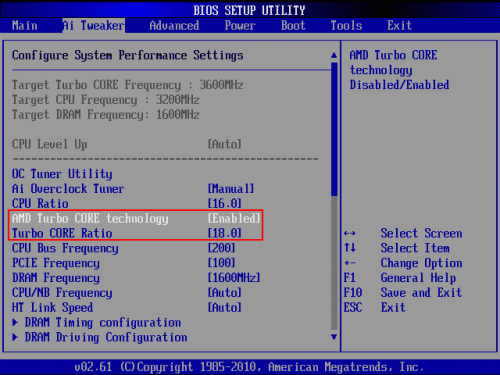
By the way, I would also like to point out one peculiarity of Turbo CORE technology working on Phenom II X6 1090T processor from the Black Edition series. Since this processor is targeted for computer enthusiasts and overclockers, it allows traditional overclocking by multiplier as well as more flexible configuring of the Turbo mode. In the BIOS Setup there appears a special option for manual adjustment of the processor clock frequency multiplier used during Turbo mode activation, right next to the option for adjustment of the regular processor multiplier. This option is available on all systems supporting Turbo CORE, but exclusively for Black Edition processors.
Phenom II X6 Model Lineup
Today AMD announced only two models of their new family: Phenom II X6 1090T Black Edition and Phenom II X6 1055T.
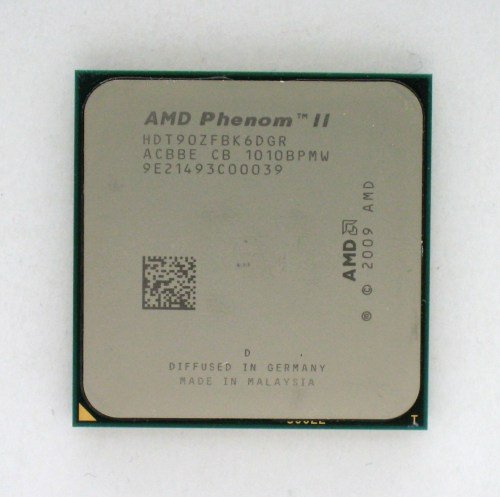
The table below shows their formal specifications:And this is what we get from the CPU-Z diagnostic utility about the flagship Phenom II X6 1090T model:
However, AMD is not going to stop at two processor models and within the next few months there will be more six-core Phenom II X6 CPUs from AMD coming out. Besides, there will also be quad-core processor based on the same Thuban with two cores disabled.
Testbed Configuration and Methodology
We are going to compare new six-core AMD processors against dual- and quad-core competitor CPUs from the same price range. For your reference, we also included the results for the new six-core Intel Core i7-980X processor, which is undoubtedly a much faster solution. Moreover, the diagrams will also show the performance numbers for the top quad-core AMD processor, which will be replaced eventually by Phenom II X6 in the mainstream price segment. As a result, we ended up with the following hardware and software components for our testbeds:
- CPUs:
- AMD Phenom II X6 1090T (Thuban, 6 cores/6 threads, 3.2 GHz, 6 MB L3);
- AMD Phenom II X6 1055T (Thuban, 6 cores/6 threads, 2.8 GHz, 6 MB L3);
- AMD Phenom II X4 965 (Deneb, 4 cores/4 threads, 3.4 GHz, 6 MB L3);
- Intel Core i7-980X (Gulftown, 6 cores/12 threads, 3.33 GHz, 12 MB L3);
- Intel Core i7-930 (Bloomfield, 4 cores/8 threads, 2.8 GHz, 8 MB L3);
- Intel Core i7-920 (Bloomfield, 4 cores/8 threads, 2.66 GHz, 8 MB L3);
- Intel Core i7-860 (Lynnfield, 4 cores/8 threads, 2.8 GHz, 8 MB L3);
- Intel Core i5-750 (Lynnfield, 4 cores/4 threads, 2.66 GHz, 8 MB L3);
- Intel Core i6-670 (Clarkdale, 2 cores/4 threads, 3.46 GHz, 4 MB L3).
- Mainboards:
- ASUS M4A89GTD PRO/USB3 (Socket AM3, AMD 890GX + SB850, DDR3 SDRAM);
- ASUS P7P55D Premium (LGA1156, Intel P55 Express);
- Gigabyte X58A-UD5 (LGA1366, Intel X58 Express).
- Memory:
- 2 x 2 GB, DDR3-1600 SDRAM, 9-9-9-24 (Kingston KHX1600C8D3K2/4GX);
- 3 x 2 GB, DDR3-1600 SDRAM, 9-9-9-24 (Crucial BL3KIT25664TG1608).
- Graphics card: ATI Radeon HD 5870.
- HDD: Western Digital VelociRaptor WD3000HLFS.
- PSU: Tagan TG880-U33II (880 W).
- OS: Microsoft Windows 7 Ultimate x64.
- Drivers:
- Intel Chipset Driver 9.1.1.1025;
- ATI Catalyst 10.3 Display Driver.
Performance
General Performance
SYSmark 2007 testing suite showing the systems performance during regular complex work in popular applications doesn’t rate new six-core AMD processors that high. The thing is that far not all applications can split the load in six equal threads and that has a serious effect on the results in this case. As for Turbo CORE technology, it is no panacea in this case and the results show it clearly. Yes, Phenom II X6 1090T runs as fast as Phenom II X4 965, but that’s as good as it gets. Overall, six-core AMD CPUs yield to Intel solutions from the same $200-$300 price range.
At the same time, Phenom II X6 processors perform pretty well in applications working with video content. They run as fast as the junior Lynnfield processor in Adobe After Effects, Adobe Photoshop, Adobe Illustrator, Sony Vegas and Windows Media Encoder. Although the Lynnfield CPUs from Intel have only four computational cores, they belong to the same price range and hence are direct competitors to AMD’s six-core products.
Gaming Performance
Back during the first Gulftown tests we already saw that contemporary games can’t really take advantage of six-core processors. Today we can only once again confirm the same conclusion: at this time games obviously have no use for six-core Phenom II X6 processors. Phenom II 965 is slightly faster than both six-core AMD CPUs in most cases, even though AMD tried to use Turbo CORE technology to make up for their slightly lower clock frequency. In other words, Intel quad-core processor seem to be the best choice for gaming these days, because their microarchitecture is best suited for the type of load created during contemporary gameplay.
However, to be fair we have to say that both, Phenom II X4 and Phenom II X6, are powerful enough to deliver pretty high fps count. And it means that in reality the major bottleneck of the contemporary gaming system will be not the CPU but the graphics accelerator, which should be picked out very thoroughly for this reason.
Synthetic Benchmarks
We included the calculation of 32 million digits of the π number for one reason: it uses only one computational thread. Therefore, it becomes an excellent test for processors working in Turbo mode, which is now supported not only by Intel processors but also by CPUs from AMD. And as we see from the diagrams, Turbo CORE technology implemented in Phenom II X6 turns out pretty efficient. The top six-core AMD processor is significantly faster than the top Phenom II X4 model, catching up with Core i7-860 working at 3.46 GHz when the load is single-threaded.The processor test from, the 3DMark Vantage suite splits the load into parallel threads according to the number of available processor cores. Unfortunately, Phenom II X6 processors don’t do that well here. The best they can do is to outperform the quad-core Core i5-750. As for Core i7 processors that have not only four physical cores but also four virtual ones due to Hyper-Threading technology, they prove to be much faster.
Performance in Applications
Now that we have measured Phenom II X6 performance in several popular applications we can draw a very sad conclusion that new six-core AMD processors can only compete successfully against quad-core competitor solutions that do not support Hyper-Threading technology. As for Core i7 processors, which do support this technology, they will be faster in most cases. So, Phenom II X6 should probably be considered an alternative to Core i5 CPUs at best.
However, it is not always the case. There are a number of tasks where new AMD processors do really well. These are the tasks dealing with video processing and transcoding. This is where Phenom II X6 look way better than in all other cases, they even run faster than Core i7-860 or Core i7930. So if you work with media content a lot, we would strongly recommend you to consider the new AMD processors.
Power Consumption
Formally, the increased number of processor cores in the new Phenom II X6 CPUs didn’t affect the TDP value. Just like by other top Phenom II processors, their TDP is set at 125 W. This results from certain improvements in the utilized production process, as well as from the introduction of the new processor stepping. Moreover, do not disregard lower core voltage compared with that of quad-core Phenom II X4 CPUs, which is specified at 1.4 V.
However, it is hard to believe that 1.5 times increase in semiconductor die complexity didn’t affect the power consumption. Therefore, in order to get a more detailed picture we performed some power consumption tests. The graphs below show total system power consumption (without the monitor) measured “past” the power supply unit and representing overall power consumption of all system components. In this case we do not take into account the efficiency of the PSU itself. During our tests we used 64-bit LinX 0.6.3 utility to load the systems to the utmost extent. Moreover, to ensure that we estimate the power consumption in idle mode correctly we activated all power-saving technologies, such as C1E, AMD Cool’nQuiet 3.0 and Enhanced Intel SpeedStep.
In idle mode Phenom II X6 based Socket AM3 system consumes just a little more power than a similar system with Phenom II X4 965.
We see the same exact picture under heavy load. As promised, the power consumption of the new six-core AMD processors is not very much different from that of the top Phenom II X4 CPU. And it means that Phenom II X6 based platforms boast higher energy-efficiency than their predecessors as well as LGA1366 systems. However, LGA1156 platforms still outperform them in this respect.
Overclocking
Unlike Intel, AMD decided not to involve more advanced manufacturing process for the production of their new processors. But despite this fact, we expect to see a certain improvement of their frequency potential anyway, because the enhancements of the 45 nm process introduced by AMD’s production partner, Globalfoundries Company, did in fact allow lowering the heat dissipation of each core even without the use of “fine” transistors.
To check out this hypothesis we tried overclocking Phenom II X6 1090T Black Edition processor. I would like to remind you that this processor boasts an unlocked clock frequency multiplier, which allows increasing its clock frequency fairly easily. Of course, we couldn’t pass on this great opportunity during our overclocking experiments. We used LinX 0.6.3 utility to test stability during overclocking. The CPU was cooled with Thermalright Ultra-120 eXtreme air-cooler. Turbo CORE technology was disabled during our overclocking tests.
First of all we decided to check how far we could push the frequency of our six-core Phenom II X6 1090T at its default Vcore. As we have revealed in one of our recent articles, this type of overclocking is the most energy-efficient one and doesn’t lead to dramatic increase in power consumption and heat dissipation.
Practical tests showed that the system remained stable at 3.7 GHz maximum frequency and nominal processor core voltage.
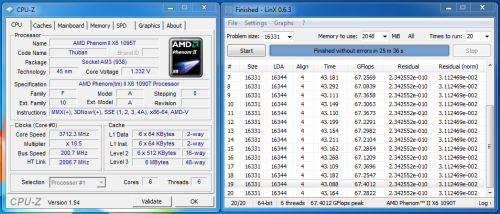
The funny thing is that without adjusting the CPU Vcore our processor reached a higher frequency than it would in Turbo mode, when its Vcore would be increased automatically. In other words, it looks like Turbo CORE doesn’t really need higher voltage to work just fine, but there is no way to disable the Vcore increase.
We also tried overclocking our processor by raising its Vcore. For this second part of our experiments we set the CPU core voltage to 1.475 V, which was exactly what the CPU Vcore would be in Turbo mode. We didn’t raise the voltage any further on purpose, because for a six-core processor it may increase power consumption and heat dissipation catastrophically. In this case we managed to pass stability tests at 4.0 GHz.
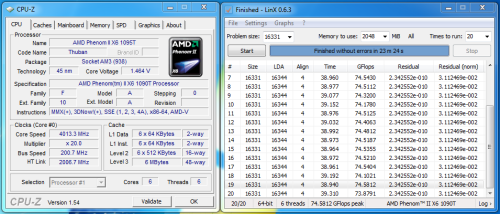
Here I would like to point out that our test CPU could load the OS and pass some tests even at 4.2 GHz frequency, but it failed a full stability check in this case. That is why we consider 4.0 GHz to be the final result of our overclocking tests. In other words, Thuban frequency potential is at least as good as that of quad-core Phenom II X4 processors. So, I am sure that overclocking fans will be very pleased with the new AMD offering.
Unfortunately, we can’t tell you anything about the temperatures of an overclocked Phenom II X6 1090T. The temperature readings reported by the CPU itself are incorrect and the numbers according to all diagnostic utilities are obviously lower than the actual values. Maybe the thermal diode in the first batch of six-core processors wasn’t calibrated right, or maybe this issue should be fixed in the mainboard BIOS. However, we can estimate the thermal and electrical parameters of the overclocked processor knowing that its actual power consumption at 4.0 GHz frequency under peak load is about 260 W.
4.0 GHz seems to be a pretty good achievement for Phenom II X6 1090T; this frequency is 25% higher than the nominal one. However, the performance of the overclocked six-core AMD processor turns out lower than anticipated. The results of our express-test indicate that clearly. During this test we compared the performance of our overclocked Phenom II X6 1090T against that of Core i7-930 also overclocked to 4.0 GHz.
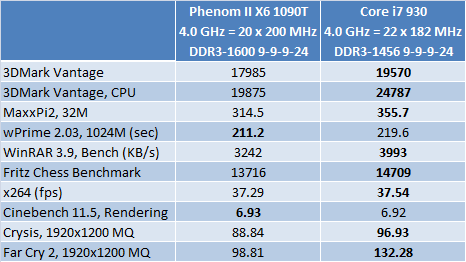
Strange as it might seem, but a quad-core CPU on Intel Nehalem microarchitecture with Hyper-Threading technology overclocked to 4.0 GHz almost always outperforms six-core CPU from AMD. At the same time I can’t say that Thuban’s frequency potential is higher that of Core i7 CPUs on Lynnfield and Bloomfield cores. Therefore, there is only one possible conclusion here: microarchitecture of contemporary Intel processors makes them faster than AMD processors working at the same clock frequency. And even a 1.5 times increase in the number of computational cores can’t make up for that. That is why we again arrive to the same conclusion that AMD’s only weapon in the battle for consumers is their pricing policy.
However, Phenom II X6 1055T may become a pretty attractive solution for overclocking. This CPU competes against Core i5-750 that doesn’t support Hyper-Threading. And if the junior six-core AMD processor can overclock to 4.0 GHz, then it may end up being faster than its overclocked competitor.
Conclusion
I believe no one will deny that Stars (K10.5) microarchitecture used in contemporary AMD processors has become pretty obsolete and is inferior to Nehalem microarchitecture in many aspects. However, it doesn’t mean that AMD can’t roll out up-to-date solutions. And Phenom II X6 is a living proof of that. Of course, this six-core processor is no ultimate winner, but the manufacturer managed to adjust the existing microarchitecture in such a way that it made Phenom II X6 a very interesting product that will undoubtedly win numerous users’ hearts.
Compared with the previous generation Phenom II flagship CPUs, the six-core newcomer boasts several advantages. First, Phenom II X6 has 1.5 times more cores, which makes it much faster under multi-threaded load. Second, Phenom II X6 shows pretty acceptable power consumption level due to enhanced 45 nm process and lower nominal processor core voltage. Third, more cores didn’t harm the overclocking potential of the new processors and they can easily hit 4.0 GHz barrier. Fourth, Phenom II X6 features new Turbo CORE technology that increases the processor performance in case of poorly paralleled load.
But it is the pricing that makes Phenom II X6 truly attractive and AMD has lately become very successful in this respect. The official price of the new Phenom II X6 1090T is set at $300, while the junior Phenom II X6 1055T is priced at $200. It means that six-core AMD processors belong to the mainstream price range and are the only affordable multi-core processors out there. This factor will undoubtedly guarantee the popularity of these processors.
Especially, since our tests showed that six processor cores may be very helpful during work with video content, and that becomes an increasingly popular type of activity these days. However, there are other applications as well, where six Phenom II X6 cores may come in very handy. Six-core processors raised the performance bar for Socket AM3 systems so that now they can compete successfully against platforms based on top Core i5 processors with four cores. However, unfortunately, six-core Phenom II X6 CPUs turn out even slower than quad-core Core i7 processors supporting Hyper-Threading technology.
In conclusion I would like to stress that six cores are not always better than four. There is still quite a bit of software out there that is not optimized for multi-core architectures. And it means that there are quite a few tasks that work best on dual- and quad-core CPUs. Among them are contemporary games, of course. Therefore, if you are looking to build a gaming system, Phenom II X6 will be far not the best choice despite all its indisputable advantages.